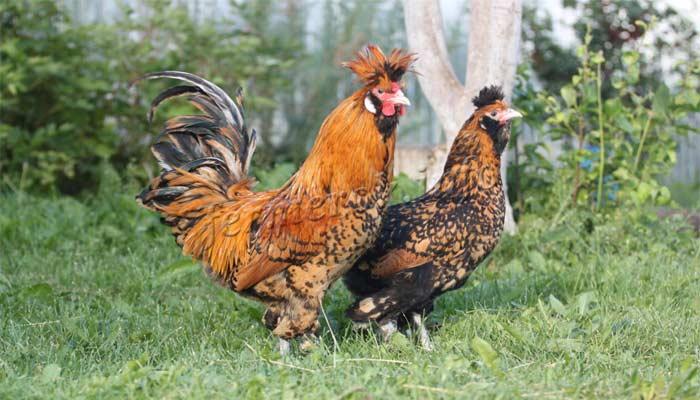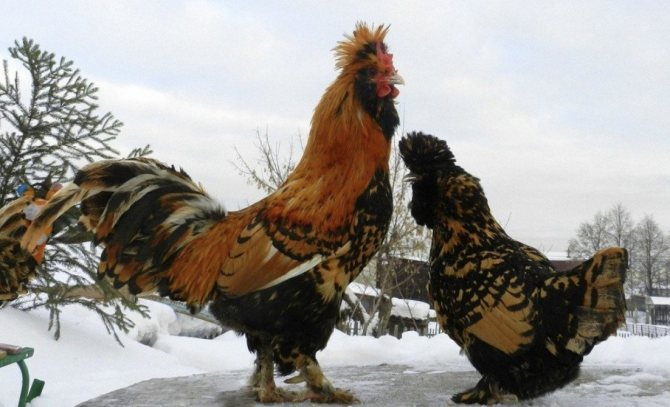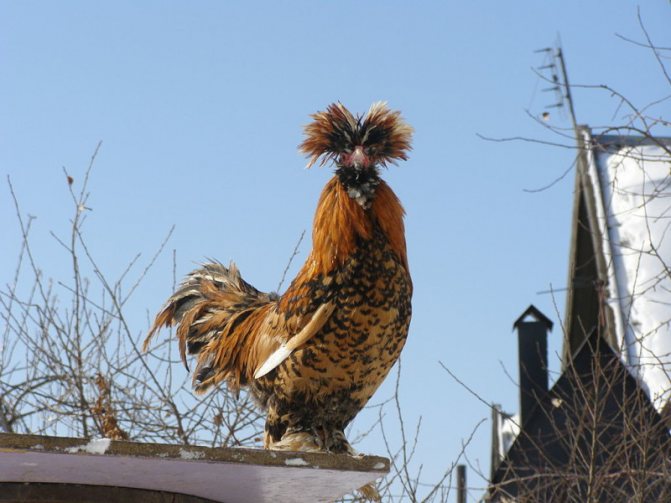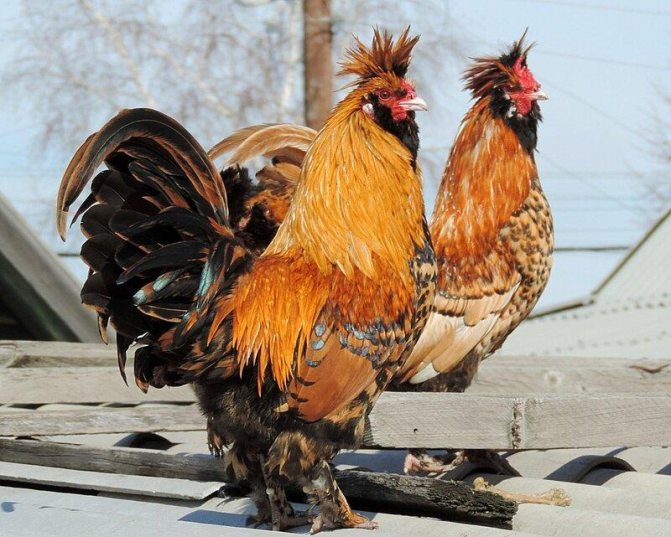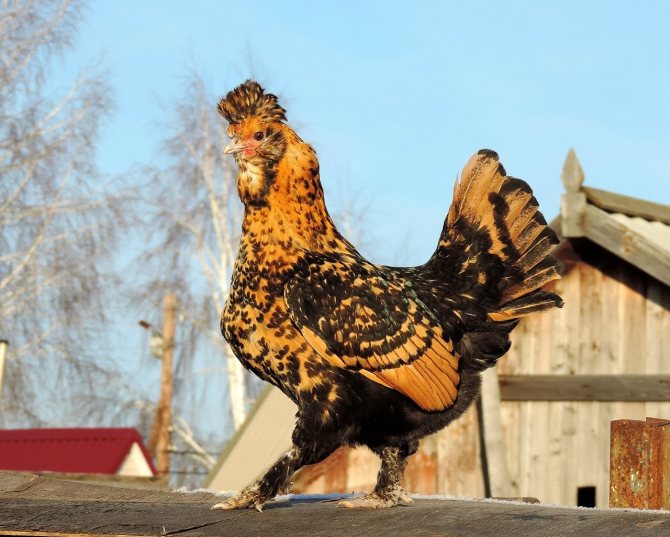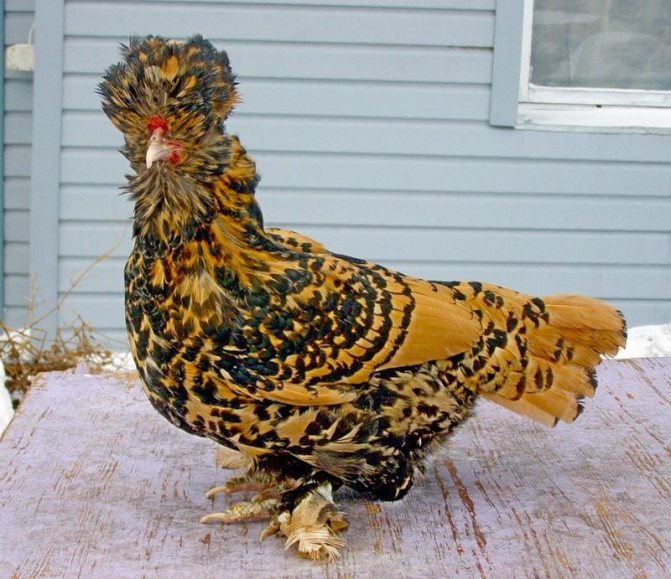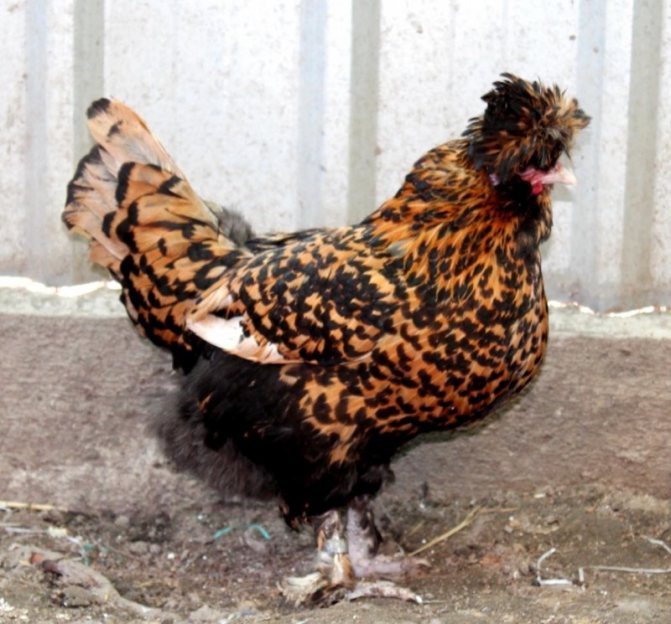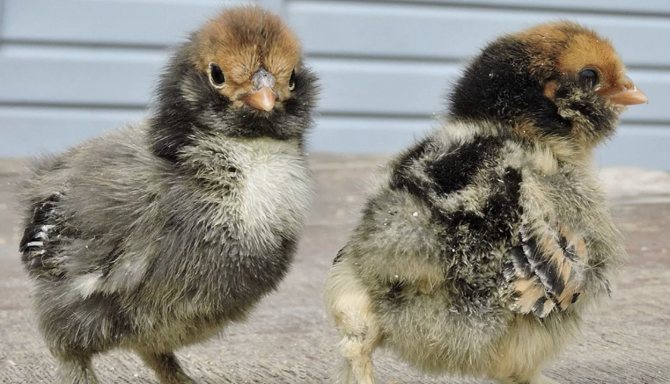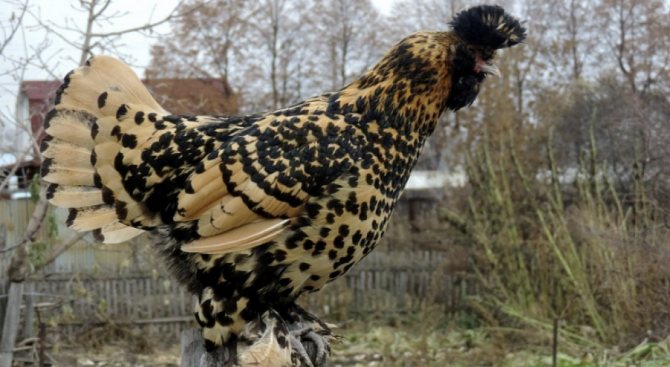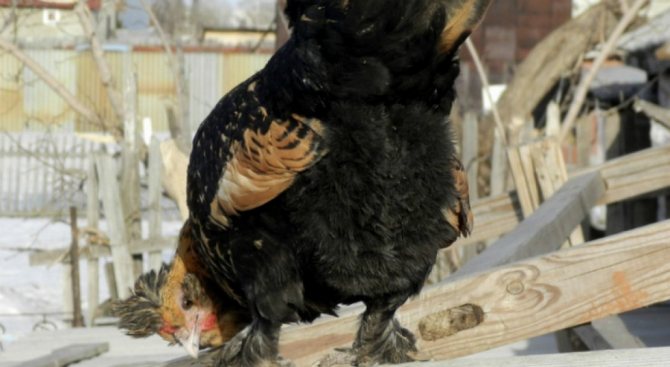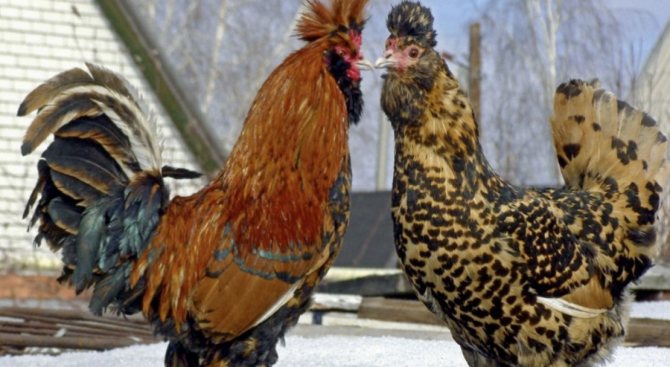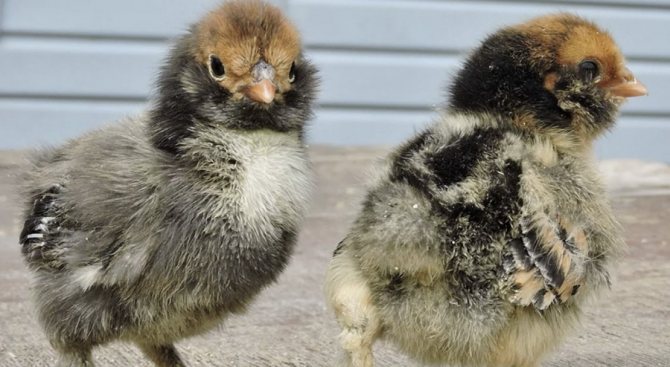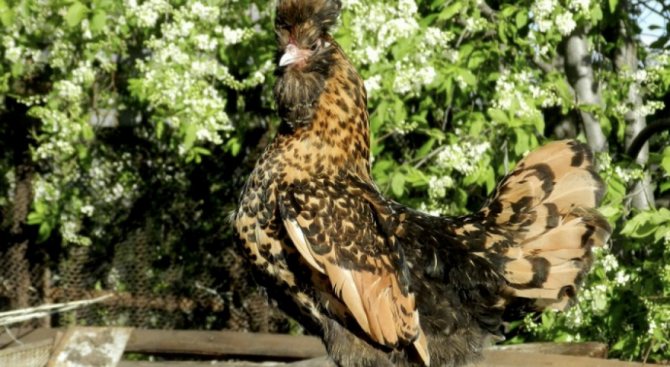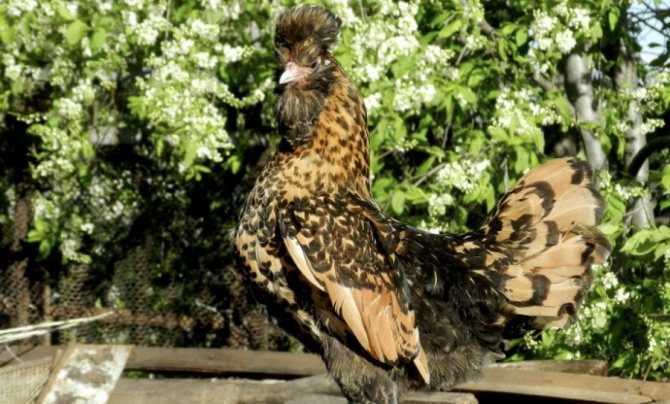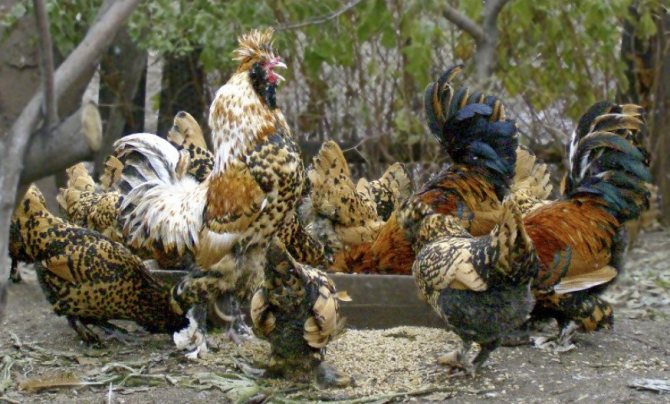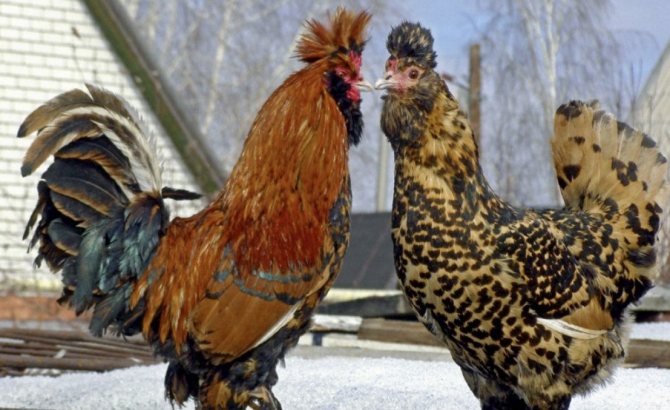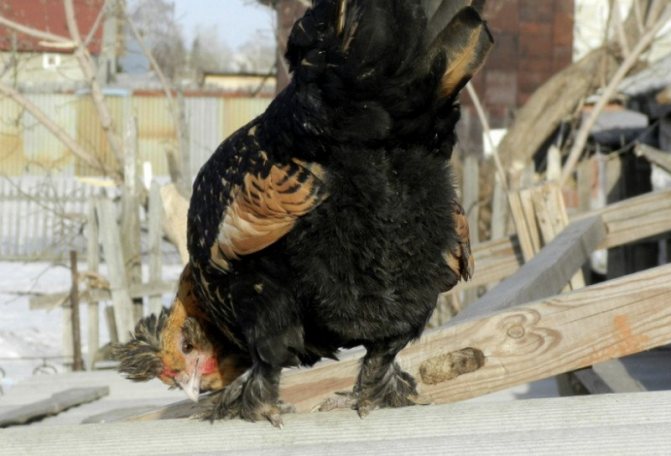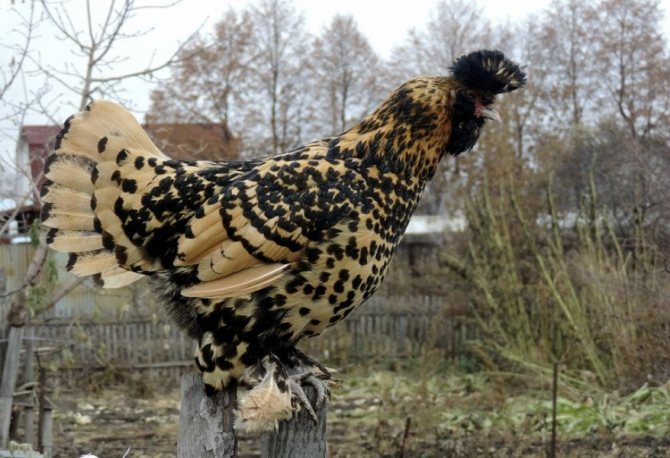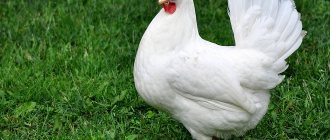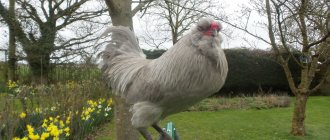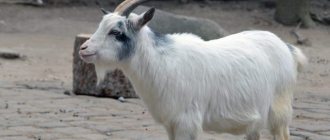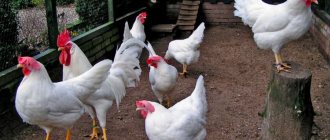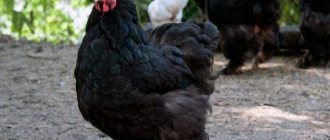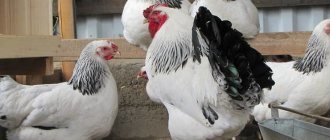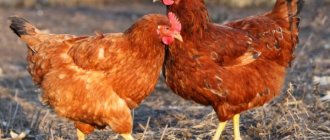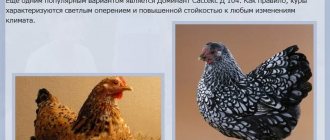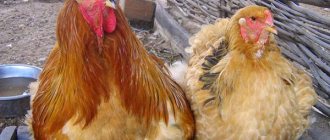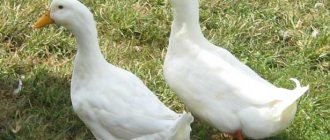History of the breed
There is no consensus among researchers about the origin of these wonderful chickens. Some believe that they are descendants of representatives of Persian breeds, others - of Turkish, and still others are sure that this is a mixture of ordinary Russian chickens and Cochinchins. In any case, this breed was first brought to the All-Russian Acclimatization Exhibition from the village of Pavlovskoye, Nizhny Novgorod province. Hence its name. This event happened in 1878. And in 1899, the committee of the International Poultry Exhibition declared this species a national decorative breed of Russia.
At the same time, two of its varieties were officially recognized - silver and golden. Later - in 1905 - black Pavlovsk chickens were also allocated as an independent breed. This variety is called the Siberian Upland.
After the revolution, the wonderful breed we are considering was almost completely bred in the country. They began to revive it only in the 80s in Leningrad (VNIIGZH). Modern farmers have appreciated the remarkable qualities of the breed, and today it can be purchased for divorce in poultry farms.
Origin
The Pavlovsk breed is considered one of the oldest that arose on the territory of Russia. There is no exact information about its origin and time of occurrence, but it is known that the first breed individuals appeared in the village of Pavlovo, located in the Nizhny Novgorod province. The villagers, among other activities, raised various poultry, including chickens. Gradually they developed a local breed called Pavlovskaya.
From the 18th century, chickens began to spread throughout Russia, and in the 19th century - to many European and Asian countries. In them, they began to enjoy popularity (it is believed that Pavlovsky chickens gave rise to all European crested breeds of that time), but at home by the end of the century they practically disappeared.
Exterior
The appearance of the Pavlovsk chickens, as already mentioned, is rather peculiar. Particularly charming is their large curled crest in the shape of a helmet. The owners of the luxurious "accessory" are not only cockerels, but also hens. The plumage of the representatives of this breed is bright, contrasting - black dense spots on a golden or silver background. In addition to the helmet, the magnificent plumage on the legs, stretched back in the form of spurs, gives the Pavlovian chickens a spectacular appearance.
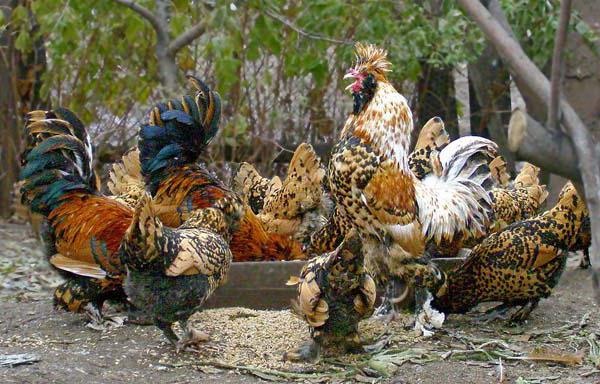
The body of Pavlovsky chickens (golden and silvery) is well developed, distinguished by its massiveness, but at the same time it is quite graceful. Their tail is raised rather high and curled. The scallop and earlobes are practically absent. The head of both chickens and cockerels is small, free-rounded.
Characteristic
Breeders divide Pavlovsky chickens into:
- golden-spotted (the base of the color is brown with a tint of gold, and the tips of the feathers are black. Dark spots cover the lower back, shoulders, neck, wings and are similar in shape to the sign of a bird "V". Flight feathers are golden, darker outside than inside);
- silver-spotted (the color is based on a silver-white color, dark blotches are similar to the previous color).
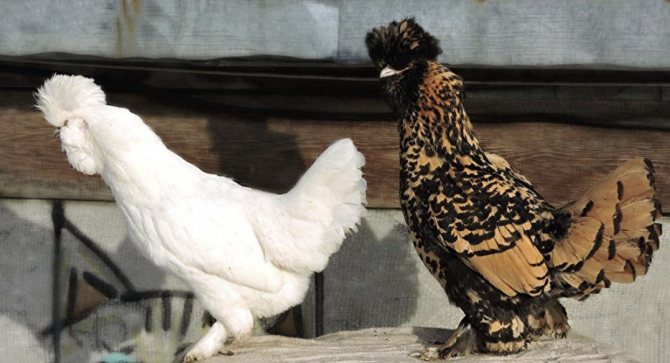

There are also:
- white (plumage is completely snow-white);
- porcelain (very variegated color, it is difficult to highlight any basic tone);
- yellow or fawn;
- black (from the tip of the beak to the tip of the tail, the bird is colored black).
Important! The last four varieties are very rare and quite often rejected due to non-compliance with standards for some characteristics.
What should be a barn
The barn for these chickens is not made too high. They also do not need too much area. A shed of 3x3 m is enough for a dozen chickens. Its height should not exceed 2 m, otherwise the bird will be cold in winter. It is desirable to insulate the structure. The cheapest option would be a frame structure with walls lined with mineral wool. When building it, it is important to ensure that there are no cracks or holes left for the ferret to crawl through.
Chicken coop floors can be adobe or wood on logs. It will be cold on concrete chickens. The floors should be covered with hay, straw or sawdust. Pavlovsk chickens are not too large and do not retain heat well. Therefore, it is better for them to equip a heated dwelling. They cannot stand such low temperatures as ordinary chickens.
It is imperative to make a window in the hen house. For normal development, the bird needs sunlight and fresh air. A manhole with an insulated door should be arranged in one of the walls. At the same time, a small courtyard is fenced off from its outer side.
Temperament
Pavlovsk chickens are active, mobile, love to run. Distinctive behavioral trait - fussiness, the ability to fly over obstacles by changing the direction of flight.
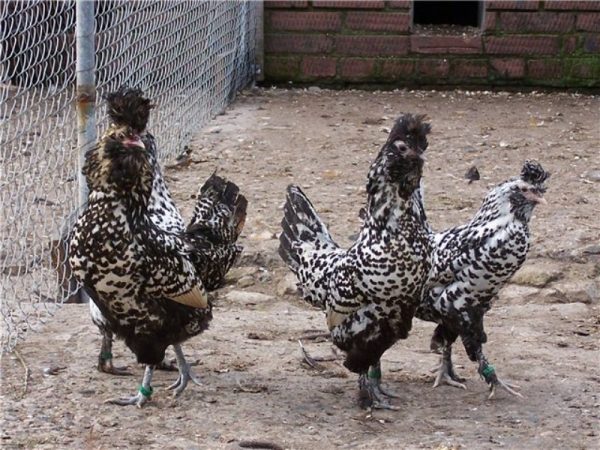

Roosters are cocky. Despite the belligerence of males, chickens get along well with other breeds of birds - ducks, geese, turkeys, guinea fowls.
Gullible and friendly towards people. Tied to the coop, don't try to escape.
Advice: For roosters, given their warlike nature, a separate place is fenced off in the hen house.
How to equip a chicken coop
Perches, feeders and nests must be done according to certain rules. In this case, it will be more convenient for the chickens, and it will be easier for the owners to take care of them. Perches are usually installed at a height of about 80 cm. Do not place them under windows, otherwise the bird will catch cold.
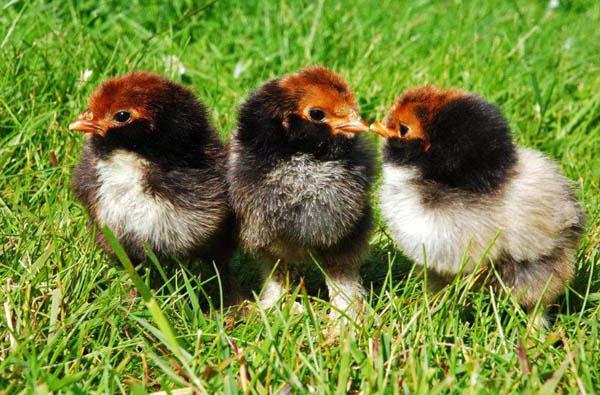

The nests can be nailed to the walls next to the perches or simply placed on the floor. The optimal size is 35x30x30 cm. Inside they are lined with hay or straw. It is advisable to put inside the blende - white stones that have the shape of an egg. In this case, domestic chickens will not peck real ones.
Feeders are best placed on legs. Raising them a little off the ground will help the chickens scatter less food. Above, above each feeder, a "turntable" is installed. For its manufacture, two bars are taken and a pole is attached to them in such a way that it rotates around its axis. Further, the structure is attached to the top of the feeder. This simple device is necessary to prevent chickens from getting into the feeder and leaving no droppings in it.
Feeding
Two-thirds of the diet of layers should be roughage - crushed grain, grain, bran, compound feed. Also, these birds are fed with mash. To do this, rub carrots, beets, potatoes, apples in a bowl, cut nettles, cabbage, etc. Then add a little white bread and bran. The resulting mixture is salted and a little chalk and flour - fish or meat - are added to it. There are also special mixtures designed to increase egg production. You can add them too. In the morning and in the evening, the bird is fed with grain. The mash is served for lunch. In addition, from time to time, you should throw cabbage leaves, beets, carrot tops, nettles, etc. into the yard for chickens.
Features of keeping birds in a private farm
Pavlovsk layers and cockerels need to be raised in spacious and warm chicken coops, periodically releasing them for a walk in the yard. In tight and narrow cages, this breed is not bred due to the high mobility of chickens.
In the corrals, poles are installed (from the floor - at a height of about 0.9 m). There is no need to attach additional stairs and steps to them. Chickens are happy to roost on their own. It is not necessary to heat the chicken coop even in extreme cold. The bird tolerates frosts without any problems.
In summer, chickens should be allowed to walk as often as possible. It is optimal to build for these purposes a separate lightweight poultry house with perches.
An important nuance! There should be no drafts in the places where the perches are installed.
Chicken care
Maintenance of the Pavlovsk breed requires a minimum of time. Chickens should be fed regularly, once a month they should be treated with insect parasitic agents.
In the nests where the birds lay their eggs, the hay needs to be changed once a month. And the common bedding in the chicken coop is replaced every 10-12 months, not more often.
It is recommended to regularly collect the laid eggs. Pavlovka can break the shell and feast on its contents. If possible, it is advisable to mount nests with special egg collectors.
Every 50-60 days, the feeders and drinkers are thoroughly washed. With the onset of cold weather in the poultry house, it is necessary to extend the daylight hours, using artificial light lamps for these purposes. In winter, the light in the main pen should be on for 14-16 hours.
Food
In the summer, free-range chickens are kept at a minimum cost. They are given a small amount of standard mixtures. The birds will get the rest of the food themselves. They will begin to nibble the grass, actively eat the seeds of various plants, worms and small insects.
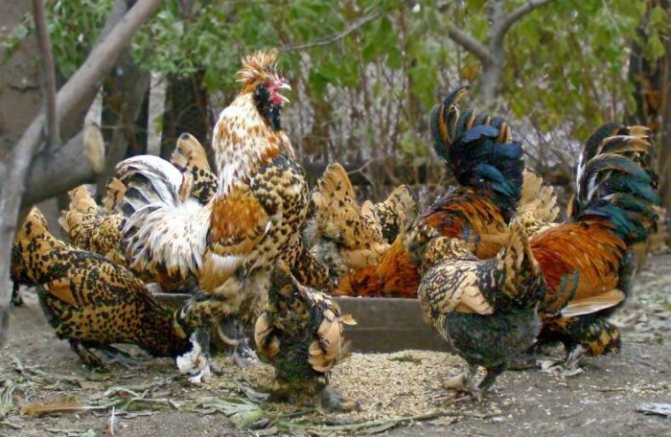

Chicken nutrition
If summer walking is performed on a large free area, the usual diet is reduced by about a third (from 50 to 30–35 grams per individual). It is enough to feel the goiter of the chicken to understand whether it is eating up or not. When this part of the esophagus is little or completely empty, the bird needs to be given more food.
Important! In drinking bowls, the water is changed twice a day - in the morning and in the evening. If they are severely contaminated, the fluid is replaced as needed. The water in the drinker must always be clean!
In winter, the diet must contain grass flour, grain mixtures, mineral and vitamin premixes, small amounts of whey, mixed feed, wet mash. Chickens need to be given fish, meat and any other waste from the human table, the main thing is that they are not rotten and sour.
Reviews about Pavlovsky chickens
Of course, hardly anyone will breed this breed seriously to get eggs or meat. However, the reputation of the most beautiful in Russia - if not in the world - remains with her to this day. These are actually very spectacular poultry - Pavlovsky chickens. Reviews about them are often just enthusiastic. Especially in women. These chickens are usually kept and bred just as decorative. As for the complexity of care, most farmers agree that this bird is not only very unpretentious, but also friendly.
This breed is also of interest to farmers by the fact that it was revived quite recently. In 1988, at an auction in Italy, a couple of Pavlovian chickens were sold for $ 2.5 million! Of course, now, when quite a few farms around the world are engaged in breeding the breed, it costs much less - no more than 200-300 rubles per head. Therefore, any summer resident can afford to buy a couple of these handsome men for their own pleasure and in order to cause envy and delight among friends and acquaintances.
Some believe that breeding such a variety as the Pavlovsk breed of chickens is, among other things, quite profitable. The fact is that chickens, hatching eggs and adult birds are bought very willingly. Therefore, many keep them for divorce and sale.
As for the features of care, then, despite its unpretentiousness, this bird, like any other living creature, of course, requires attention to itself. As mentioned above, the shed for her, most likely, will have to be thoroughly insulated. In addition, to reduce the risk of morbidity in the winter, many farmers advise giving these chickens special supplements. However, in general, their immunity is assessed as very stable.
Maintenance and care
The exactingness of Pavlovsk chickens to care and maintenance is due to the fact that they are an ornamental species.
- The bird loves freedom, walking, so it keeps in a comfortable chicken coop. 5-6 chickens are added per square meter.
- The hen house should be insulated, because in winter the bird can freeze, especially in the northern or even in the middle regions.
- The appearance of this bird is its main advantage, therefore it is impossible to keep them in the mud. Cleaning takes place every 3 days, although this depends on the number of individuals. To maintain cleanliness, you just need to pay more attention to the floor, windows, perches, nests - everything should be clean, or almost clean.
- Pavlovsk chickens are mobile, active and curious, so they are equipped with a large walk with an abundance of secluded places, greenery and a high fence.
- On the walk and in the chicken coop, a basin with ash and sand is placed so that the birds clean the feathers.
Important!
Vitamin supplements in winter for this bird are very important, otherwise they may start to get sick. In summer, there are enough vitamins without premixes if the bird regularly walks and has access to greens, worms and other delicacies.
In nutrition, the breed is not picky, they give chickens grain, premixes, and also add fishmeal to the diet. Chickens and roosters can eat the simplest food and find themselves lunch and even lunch on the walk. In winter, however, you have to spend more money, because there is no pasture, but breeders do not complain about the gluttony of the bird, because Pavlovsky chickens eat a little.
Moscow chickens
This breed was bred on the farms of the Moscow region in the last century. Its ancestors are brown Leghorns, Hampshire and Yurlovsky. The Moscow breed of chickens was approved in 1980. This bird is bred for meat and eggs. In addition, it is used for crossing with chickens of egg breeds when breeding hybrids. The resulting crosses are very productive. For example, from hybrids, you can get about 250 eggs per year. Their meat is characterized by simply excellent taste.
The plumage of Moscow domestic chickens is very beautiful - dark with gold. In females, only the neck is yellow-brown, in males - a similar color is present on the back. The former can gain weight up to 2.3 kg, the latter up to 3.5 kg.
Adler silver chickens
A breed of meat and egg direction, bred in the city of Adler by crossing several varieties: New Hampshire, Russian White, Yurlovskaya, May Day and White Plymouth Rock. Differs in high productivity and unpretentiousness. The growth of these hens is medium, and the body is compact, with good meaty forms. The plumage of the Adler breed of chickens is light. Her tail is rounded with short braids. The head of both hens and cockerels is of medium size.
Adult chickens reach a weight of 2.8 kg, males - up to 4 kg. Egg production in Adler chickens is slightly lower than in Moscow - about 180 eggs per year. Their meat is light in color and is considered very tasty. Among other things, Adler chickens are used as producers in breeding meat breeds. At the moment they are considered very promising.
Diseases of Pavlovsk chickens
Nature has endowed Pavlovsk chickens with good immunity, so if the vaccine was given to the young generation on time, then serious ailments will bypass your livestock.
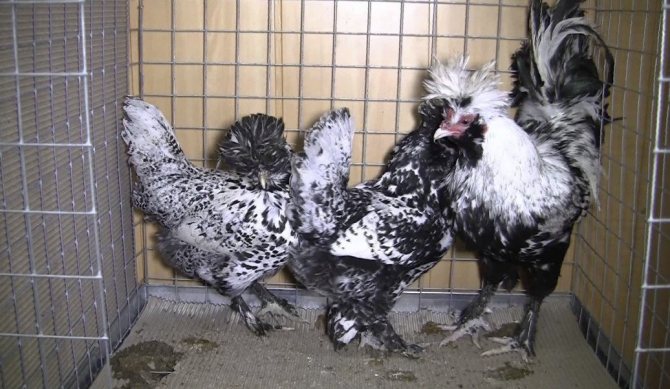

But birds still have health problems. They are usually associated with poor care:
- disorder of the digestive system;
- stress;
- eggs without shell;
- cannibalism.
Usually, such problems are solved by revising the diet of birds, adding vitamin and mineral complexes to it and increasing the duration of walks. If the measures taken did not help, or if there were some more changes in the condition of the birds for the worse, then it is necessary to call the veterinarian.
We have described a unique breed. Such beautiful birds with good productivity and frost resistance are rare. If you manage to acquire a pair of these beauties, then all the neighbors will envy you.
Pushkin chickens
In terms of productivity, this variety belongs to the egg direction. The Pushkin breed of chickens was approved in 2007. Females have white feathers with black stripes, while males have dark spots. The tail is set vertically, the legs are long, and the scallop is neat and erect.
The Pushkin breed of chickens is valued mainly for its unpretentiousness, coupled with good productivity. Up to 220 eggs can be obtained from one layer per year. Adult roosters of this breed weigh 2.5 kg, chickens - 2 kg. Despite the fact that too much meat cannot be obtained when breeding this poultry, they are also bred for this purpose. The fact is that the carcass of an adult individual has an excellent presentation.
Appearance and subspecies
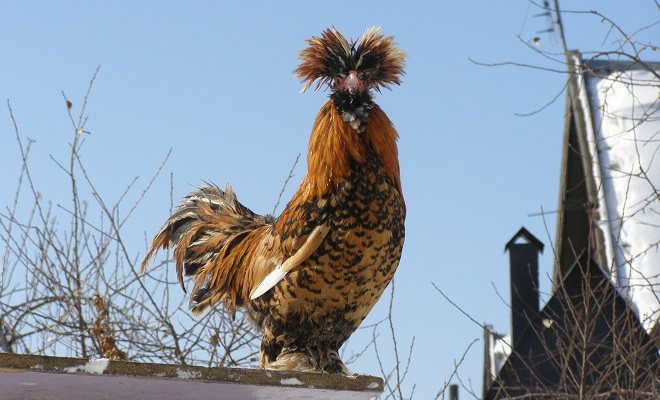

The crest is helmet-shaped. Crest in the form of half moon with two thin horns pointing up
The Pavlovsk breed of chickens is represented by light, graceful birds with an aristocratic posture. Their body has an almost horizontal setting. The small head is decorated with a helmet-shaped tuft, a voluminous beard and lush tanks.
The feathers of the tuft are vertical, so it does not close its eyes, even at significant sizes. The beak is neat, slightly curved at the end, color from pale pink to black and blue. The nostrils are slightly raised above the surface of the beak and are clearly visible. The ridge is underdeveloped. It is located above the beak across the head. A crest begins immediately behind him.
The eyes are large with cherry or almost black irises. The earlobes are hidden by feathers. The back has a pronounced taper towards the tail, and the chest protrudes forward. The tail is large, set vertically.
Pavlovsky rooster has a more magnificent plumage than a henwhich is the main sex difference.
Chickens are divided into silver and golden species.
Silver
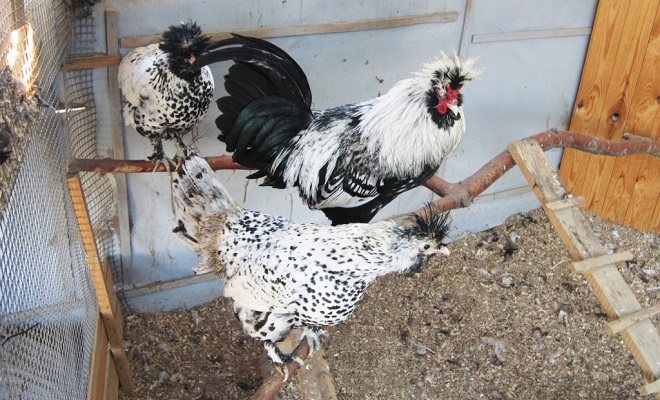

Pavlovskaya silver has the main color of the feather is white with dark gray or black blotches. Silvery chickens do not have an intense feather brilliance, only dark areas are cast green. The appearance of silver is inferior in appearance to golden. For this reason Pavlovskaya silvery breed has a smaller number, which increases its value.
Golden
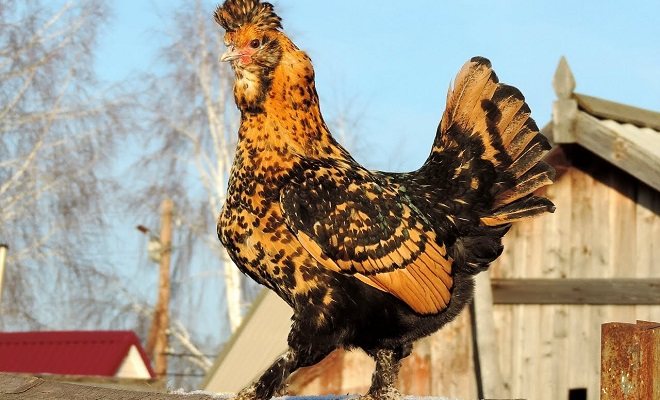

Pavlovsk golden notable for its special elegance... Birds have a brown-gold feather with black coins or crescents at the end. Gold feathers have an intense luster and shine in the sun. The type of gold is common, and it is easier to acquire it than silver ones.
Kuchinskaya jubilee
Another unpretentious and productive breed. Bred at the Kuchinsky hospital in the Moscow region. The parent breeds were Austrolorp, Striped Plymouth Rock, Leven Chickens, Brown Leghorn. In terms of productivity, the breed belongs to the meat and egg direction. The plumage of the body of the Kuchin Jubilee is reddish, the tail is raised black.
Chickens of the Yubileynaya breed are currently considered the most suitable for rural breeding. However, they can also be kept in cages. These are very unpretentious birds that do not require too complicated care. One of their most interesting features is that they do not reduce egg production even at temperatures of +3 degrees. Therefore, they can be kept in unheated chicken coops. The only thing is that the litter must be made thicker (at least half a meter).When providing a walk, these chickens easily find food, while walking quite far from home.
It is possible to breed birds of this breed both naturally and with the help of an incubator. Anniversary chickens are born healthy and strong. This breed has a very small lunge. Kuchin hens are caring mothers, they willingly accept artificially bred babies.
The egg production of this breed is very good. But only if the birds are not overfeeded. Layers also lay fewer eggs when there are too many cocks. You need to know about this. Only one cockerel is needed for 13 chickens. Up to 220 eggs can be obtained from one Kuchin laying hen per year.
These birds are also bred for meat. They have it very tasty. Chickens of the Kuchin breed gain weight up to 2.6 kg, males - up to 3.7 kg.
How to raise chickens
We have already noted that due to the price and poor prevalence, Pavlovsk chickens are hardly available to private farms. Those who could afford to have such beauty keep 1-3 heads in the courtyard.
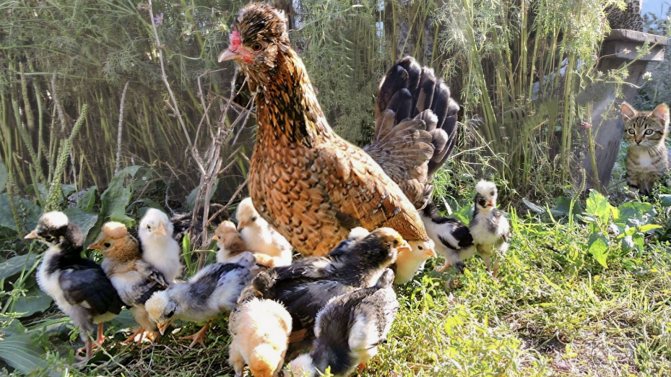

But if you managed to get at least a couple (a rooster and a chicken), then you can breed them yourself. The laying hen will hatch the chickens in 21 days, and then everything depends on you.
Correct feeding
In order for the chicks to grow strong and healthy, they need to be properly fed:
- you need to start with boiled eggs, semolina or small corn grits, fat-free cottage cheese, crushed greens;
- be sure to include vitamin and mineral supplements in the menu every other day;
- disinfect drinkers, feeders in time, replace the litter;
- place a container with calcined river sand next to the feeders;
- at the age of 10–15 days, chickens can be switched to compound feed appropriate for their age, as well as continue to give greens, vegetables, vitamins, and minerals.
Important! Chickens should not be fed with milkweed, celandine and any spoiled food.
Essential vitamins - A, E, D, group B. It is desirable that their chicks are obtained from natural products.
Young growth care
Chicks are hatched using a brood hen or an incubator. The babies born are placed in a room with a temperature of + 28 ... + 32 ° С and with a humidity of 55–65%, without drafts. In the first days of life, good nutrition and dry litter are very important for them.
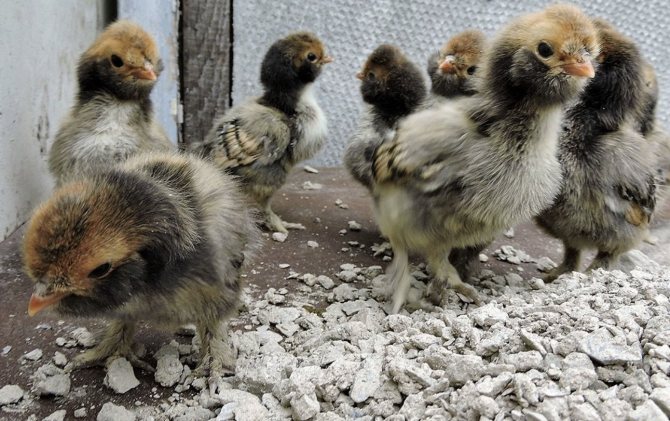

Over time, when the younger generation gets a little stronger, the temperature in the chicken coop can be lowered to + 25 ° С, and from the tenth day of their lives, they need to be reduced by 3 ° С to +18 ° С every week. The fact that the chicks are comfortable will be evidenced by their behavior. They will be active and have a good appetite. If they feel cold, they will gather in heaps and begin to squeak.
Vaccination
Pavlovsky chickens are not afraid of colds, but infectious ailments can attack, so young animals should be vaccinated against diseases of Marek, Newcastle and Gumboro, as well as prophylaxis against coccidiosis.
Whether it is necessary to vaccinate his flock, each poultry breeder decides independently. But if there are outbreaks of these diseases in your area, then vaccination is best done.
Oryol chickens
This is one of the oldest decorative chicken breeds of all raised in our country. Nothing is known for certain about its origin. According to one of the versions, it was brought to Russia long ago from Persia. According to the opinion of other researchers, the Oryol breed of chickens was bred by none other than Count Orlov. In the 19th century, this bird was kept on many farms.
These chickens are very beautiful, distinguished by their original color. In addition, they can be bred for eggs, as well as for meat. The body of the Oryol breed chickens is high, and the legs are strong. Their plumage can be different. Most often, farmers breed white, chintz, scarlet, mahogany and black chickens. One of the distinguishing features of the breed is the presence of a beard and thick tanks. A characteristic feature of their exterior is also a long neck. In this case, the back is very strongly inclined towards the tail.
Oryol breed cockerels can weigh up to 4 kg, hens - 3 kg. The average egg production is 150 pieces per year. The content of the Oryol breed of chickens is very unpretentious and tolerates frosty winters well. The disadvantages include, first of all, the fact that its representatives begin to rush rather late. In addition, the Oryol chickens fledge very slowly.
Rejection
In households, chickens are rarely culled, but the following signs of shortcomings are of great importance to preserve the purity of the breed:
- Lack of tuft;
- Strongly developed crest that covers the eyes;
- The absence of feathers on the paws;
- The presence of a fifth toe on the paws.
If the cleanliness of the livestock matters in the home yard, and the culling of chickens is not a meaningless exercise, then non-standard representatives are kept separate from the main livestock and slaughtered for meat at the age of one.
Russian white chickens
This breed was bred in Russia in the last century by crossing Leghorns with local chickens. At the moment, it is not as popular as in the 60s. Basically, this breed is bred by farmers in Azerbaijan, Uzbekistan and Turkmenistan. Russian breeders continue to work to improve it. From one Russian white chicken, you can get up to 230 eggs per year. Chickens of this breed do not hatch. They are bred only using incubators. The advantages of the breed include, first of all, resistance to such a common disease as leukemia. The meat of the Russian whites is tastier than that of the Leghorns. In addition, they tolerate lower temperatures better. Most often, this breed can be found in small farms and private farms.
Breeding features
Laying hens begin to lay at the age of 6-7 months. They continue to rush up to 4-5 years. For regular egg production, the duration of daylight hours should be at least 14 hours, but not more than 16 hours.
Incubation period
Eggs weighing about 60 g are taken for incubation. Chicks are hatched using a brooding hen or in an incubator. The incubation period takes up to 3 weeks.
Chick feeding
In the first week of life, chickens are fed with cottage cheese and a mixture of hard-boiled eggs, wheat, corn or boiled millet. Fresh grass (alfalfa, clover, nettle), as well as vegetables (potatoes and carrots) are introduced into their diet from the 3rd day.
By the end of the first week after birth, the menu of young animals includes wet and dry mash, tops, grass flour and yeast.
Chick care
Pavlovsky chickens are characterized by intensive growth and are quickly covered with plumage.
Incubator chicks are kept separately from the family, providing them with the required temperature using heating devices (reflectors and 100-150 W electric lamps):
- from 1 to 5 days - about 30 ° С;
- from 6 to 10 days - about 26 ° С;
- from the 10th - about 18 ° С.
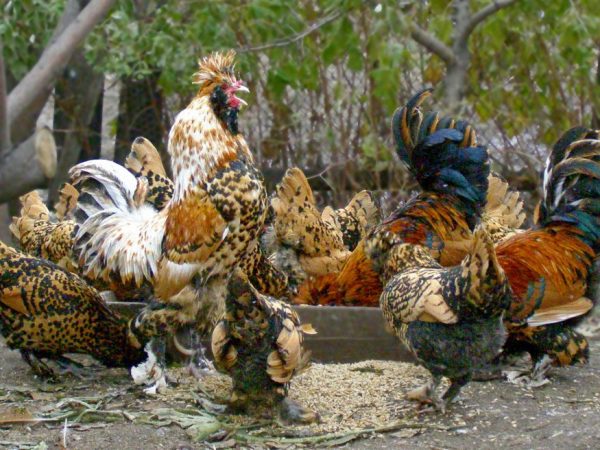

The breed is fast growing
The discomfort caused by an incorrectly selected temperature regime will be indicated by the behavior of the chicks:
- with hypothermia, they begin to fuss and clump together, lose their appetite;
- if the air temperature is too high, the chicks open their beaks, try to drink a lot and move with their wings spread.
Artificial heating is stopped as soon as the chickens are completely covered with plumage (45-50 days).
Yurlovskie
A very interesting breed developed in Russia in the 19th century. The productivity of the Yurlov chickens is somewhat lower than that of the bird considered above. One laying hen produces only about 160 eggs per year. The rooster weighs up to 3.3 kg, the hen - up to 2.5 kg. This breed is valued mainly for the loud crowing of roosters. Once the price for them depended precisely on the quality of the voice. If the rooster sang before the count of 22, it was considered the best, and was given a lot of money for it. Individuals that "held the note" up to count 18 cost a little less. The rest of the males were considered ordinary.
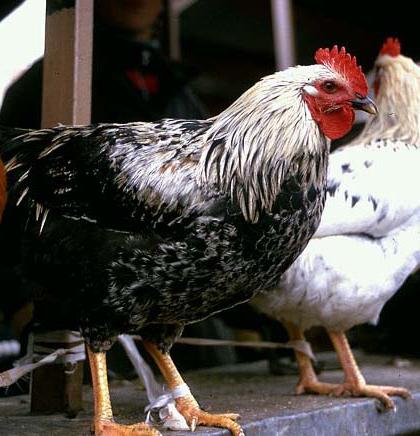

The exterior of these chickens is quite interesting. The color of the plumage is black or black with silver.The legs are thick, very strong and at the same time quite long. They can be either yellow or black in color. Most farmers consider this bird to be unpretentious in keeping.
Frequent illnesses
Pavlovskaya bird has good immunity and resistance to diseases. Vaccinations are given only when keeping large livestock.
Ash baths are also recommended for cleaning feathers and periodic prevention of helminthic infestation.
The breed has only two drawbacks - the price per individual and the number of chicks to be rejected. Little time has passed since the breed was restored, so the brood is often obtained with deviations from the standard.
To preserve the genetic code, such chicks are culled immediately or kept separately from purebreds.
Popular foreign breeds of chickens (with photos)
Of course, not only domestic chickens are raised in our country. Very good productivity can be distinguished by the "foreign" bird. For example, the Loman Brown breed, bred in Germany, can be called quite interesting. At the moment, she is considered one of the most productive. One such hen can lay up to 300 eggs per year.
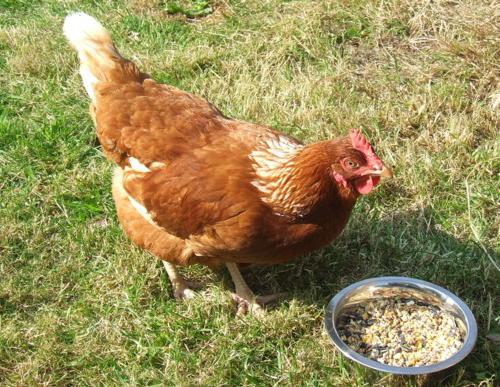

Another interesting breed is the Leghorns. These chickens were bred in Italy and brought to Russia at the beginning of the last century. From one laying hen, you can get about 250 eggs per year. At the moment, Leghorns are the most widespread breed in the world. Very often they are used to breed hybrids with high egg production rates. In Russia today there are over 20 breeding farms engaged in the improvement of this species and the creation of lines combined with it.
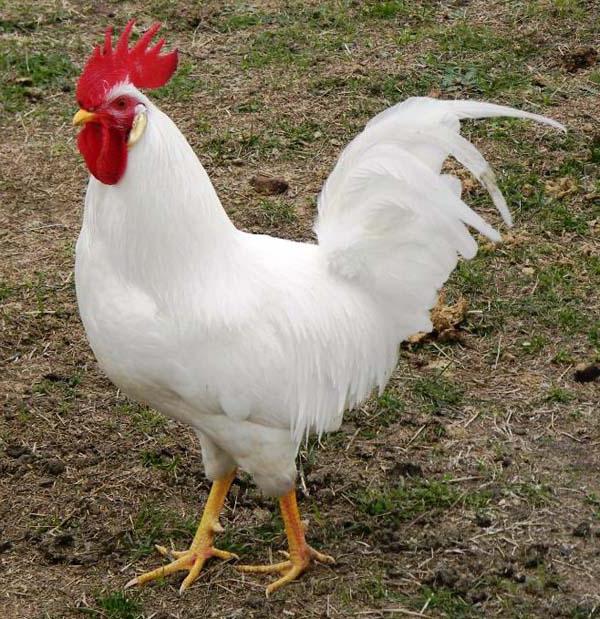

Private farmers raising chickens for sale are also very fond of this breed. The fact is that Leghorns tolerate content in cells well. The peculiarities of these chickens include the fact that in the first year they produce much more eggs than local layers. Further, their productivity in this regard is significantly reduced. Therefore, they are slaughtered already in the second year of life.
Chick care
Pavlovsk hens are good hens and mothers. Therefore, chicks are rarely bred in incubator conditions.
To obtain good offspring with a high survival rate, large, even eggs with a pronounced blunt end and no cracks in the shell are selected.
The hen needs more attention from the breeder:
- The room temperature must be at least 25 degrees.
- Periodically, you need to remove the chicken from the eggs so that she has the opportunity to eat and stretch her legs.
- When the chick is hatched, he is left with his mother.
- After a week, the temperature in the place of detention is gradually reduced to an optimal value of 18 degrees, after which the family is given access to fresh air in the warm season.
- If the chickens appeared in the hot summer, then walking is allowed from the first day of life. So that the kids do not get sick, it is not recommended to let them go outside in windy weather.
In the first days after birth, Pavlovsky chickens are fed with finely chopped eggs and cottage cheese. Here you can add boiled millet or crushed corn kernels. From the third day, fresh herbs can be added to the diet. This can be nettle, clover, or alfalfa. From the fifth day, chickens can be fed with cereal mash and yogurt with the addition of grass meal and yeast. The feed for the young should be varied and properly balanced. The correct development and safety of chickens largely depends on this.
To grow the Pavlovsk breed, you can buy chickens at a poultry farm or get them from eggs. For hatching young animals, large eggs weighing at least 60 grams should be used, which are placed in an incubator. It is equipped with electric lamps up to 150 watts. After the chicks have hatched, it is very important to observe the correct temperature regime, which should be as follows:
- from 1 to 5 days - 30-33C;
- from 6 to 10 days - 23-26C;
- from day 10, the temperature drops by 3 degrees per week to 18C.
How to choose the right breed
Thus, we have sorted out what features are the best breeds of chickens bred in our country. As for the decorative varieties, the choice is not difficult here. All you need to do is find out how well this or that breed is being sold. And, of course, be guided by your own ideas about the beauty of the bird's exterior. Ordinary breeds are chosen taking into account several factors:
- In the direction of productivity. Most often nowadays, farmers prefer to have universal meat and egg chickens. Sometimes preference is given to the breed itself, sometimes to a hybrid. In the latter case, you can get more meat and eggs, but the bird will have to be purchased from time to time. The fact is that the high productivity of crosses does not pass to the offspring.
- According to the conditions of detention. Some chicken breeds are not well adapted to the cold Russian climate.
- By egg production and weight. You should also pay attention to the taste of the meat. Eggs from chickens can have different sizes, shell colors and even shell thickness. Some breeds fly all year round, some take breaks during molting. This is also worth considering. In winter, egg production may or may not decrease, it all depends on the specific species and temperature. So the degree of insulation of the barn can also affect the choice.
In addition, before purchasing a particular breed, you should find out for which breeding method it is intended. On large and medium-sized farms, chickens are usually kept in cages. Summer residents and villagers breed them free-range. And, of course, those breeds of chickens should be chosen, the reviews of which are positive from experienced farmers.
Advantages and disadvantages
Representatives of the breed are distinguished not only by their attractive appearance. They are unpretentious in food, easily adapt to various conditions of detention and to changes in weather, and thanks to their dense plumage, they tolerate winters well. Birds have strong immunity, so they are less likely to get sick, unlike their relatives of other species. The advantages of Pavlovka also include:
- economical consumption of feed;
- high survival rate of young animals;
- excellent taste characteristics of meat and eggs;
- well-developed maternal instinct in layers.
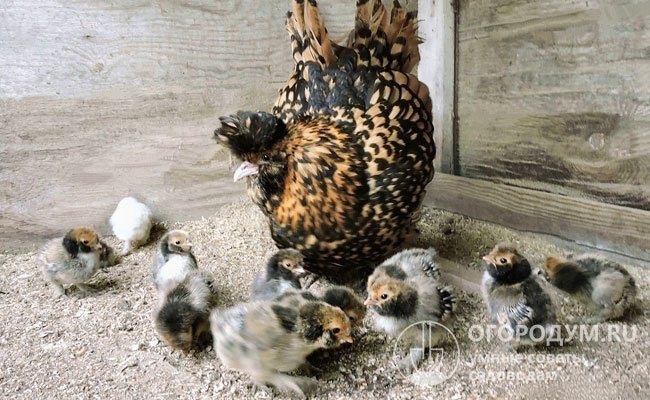

Hens closely monitor the condition of the brood, show constant care for the offspring
Among the shortcomings, breeders note low productivity, the ability of birds to fly high, their fussy and restless nature.

